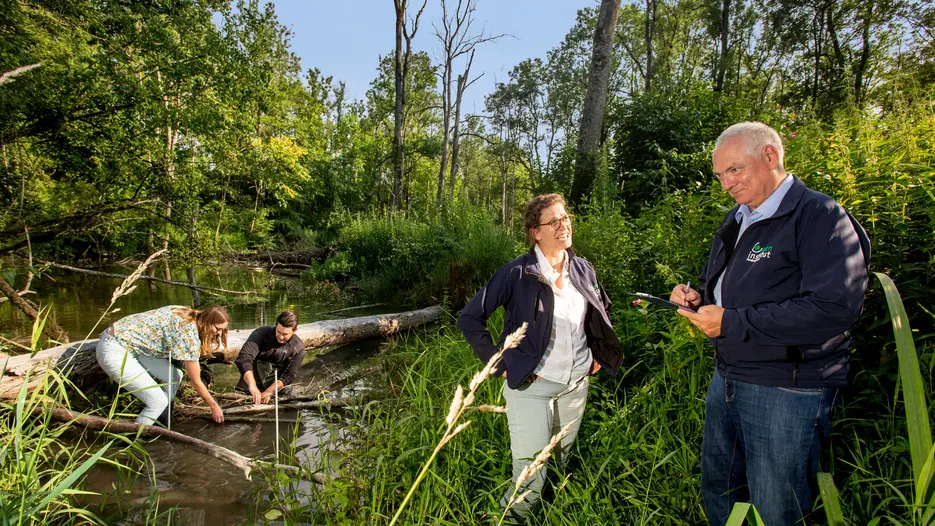How do floodplain areas along the Danube contribute to improving water quality and how can diverse interests be taken into account in their management across national borders? These questions are being researched by a consortium funded by the European Union under the leadership of the KU Floodplain Institute. The project involves over 20 institutions from ten countries along the Danube. The project "Improving water quality in the Danube system by ecosystem service based integrative management (IDES)" is the first EU joint project led by the KU and is funded with around two million euros until the end of 2022.
From its source to its mouth in the Black Sea, the Danube covers a distance of more than 2,800 kilometres, flowing through ten countries, and its water even comes from 20 different countries. Thus, more than 80 million people live in the catchment area of the river, and - just like flora and fauna - are dependent on a good water quality. The quality of the water also significantly depends on the content of nutrients that enter the Danube through agriculture, industry or wastewater and are carried further. Too much phosphate and nitrogen not only leads to oxygen deficiency and species extinction in the Black Sea, but also causes local problems along the Danube: nitrate pollution in groundwater can increase, lakes and streams can become eutrophic - i.e. over-fertilized - so that they die.
"The flow of nutrients in water does not stop at national borders. That is why it is our concern to jointly establish strategies for comprehensive water quality management with this international project. The floodplains along the Danube play a key role in this, as they are able to retain nutrients," explain Prof. Dr. Bernd Cyffka, head of the KU Floodplain Institute, and his research assistant Dr. Barbara Stammel. They coordinate the work of the participating institutions, which include the Berlin Leibniz Institute of Freshwater Ecology and Inland Fisheries, the Romanian Ministry of the Environment, the Austrian Ministry of Agriculture and the Bavarian Ministry of the Environment.
Floodplains can retain nutrients in two ways: On the one hand, near-natural green spaces along rivers prevent fertilizers or pesticides from entering into the water. On the other hand, nutrients that have already been discharged into the river can be retained again during floods: Suspended matter in the river water, to which the nutrients are bound, is deposited in the floodplain and on its plants, where it serves as fertilizer. This is one reason why floodplains often have very fertile soils - comparable to the fields along the Nile that were flooded in regular intervals.
With the current project, the researchers are building on many years of expertise from other joint projects: On the one hand, the Floodplain Institute was involved in the EU project "Danube Floodplain" for two years, which aims to improve flood protection through the conservation and renaturation of floodplains. On the other hand, the scientists have also developed a "River Eco System Service Index" (RESI) together with the Berlin Leibniz Institute, which uses a large number of indicators to show the economic importance of floodplain ecosystems in Germany. Rivers and their floodplains have many roles and tasks: They serve as shipping routes and recreational areas, as protection against floods and drinking water reservoirs, and as habitats for plants and animals. All these different types of use are planned and regulated individually by different technical authorities at different administrative levels - this makes it difficult to maintain an overview or coordinate management measures. This is where the RESI comes in by trying to evaluate all concerns in a uniform and objective way. As a basis for decision makers, the RESI index also shows indirect and long-term benefits, such as the regulation of the water balance, the retention of nutrients or the provision of habitat for the conservation of biodiversity.
"In other EU countries, too, related aspects in the field of floodplain management - such as flood protection, agriculture or biodiversity - are often considered and managed separately for planning purposes. Moreover, the question of water quality as an ecosystem service of floodplains has hardly played a role so far," explains Stammel. The aim of the IDES project is therefore to adopt a comprehensive perspective that takes this important aspect into account for the first time. The participating researchers are focusing on five pilot regions in Austria, Romania, Serbia, Slovenia and Hungary. In these regions, they seek to develop an integrated concept for the management of floodplains in close collaboration with decision-makers, which will make the diverse and mutual ecosystem services of floodplains transparent - as a basis for future handling of such areas.
Further information will soon be available on www.interreg-danube.eu/ides

![[Translate to Englisch:] Aueninstitut der KU](/fileadmin/_processed_/6/b/csm_Aueninstitut03_417f894669.webp)
![[Translate to Englisch:] Aueninstitut der KU](/fileadmin/_processed_/d/d/csm_Aueninstitut03_01_9a69e2af8f.webp)
![[Translate to Englisch:] Aueninstitut der KU](/fileadmin/_processed_/e/3/csm_Aueninstitut08_79107b9140.webp)
![[Translate to Englisch:] Aueninstitut der KU](/fileadmin/_processed_/a/3/csm_Auenwald_01_1cfee7fe46.webp)
![[Translate to Englisch:] Logo IDES](/fileadmin/_processed_/5/0/csm_Logo-IDES_56cda62497.webp)